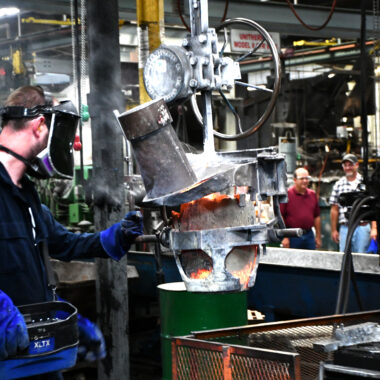Advancement Let Loose: Innovations About Aluminum Casting
Advancement Let Loose: Innovations About Aluminum Casting
Blog Article
Opening the Potential of Light Weight Aluminum Spreading: Proven Techniques for Success
Light weight aluminum spreading has long been identified for its versatility and extensive applications throughout numerous markets. Join us as we check out the necessary elements that can drive light weight aluminum casting towards exceptional success in today's affordable market landscape.
Benefits of Light Weight Aluminum Casting
Aluminum casting provides a wide variety of benefits that make it a recommended choice in various industrial applications. One of the primary benefits of aluminum casting is its lightweight nature, which adds to fuel effectiveness in markets such as vehicle and aerospace. In addition, light weight aluminum is very flexible, permitting intricate and detailed forms to be quickly created with casting processes. This flexibility in style is a significant advantage for industries that call for parts with details geometries.
Moreover, light weight aluminum spreading gives superb rust resistance, making it optimal for applications where exposure to rough atmospheres is an issue. The product likewise exhibits excellent thermal conductivity, which is useful for industries calling for warm dissipation, such as electronic devices (about aluminum casting). Moreover, aluminum is totally recyclable, lining up with the expanding emphasis on lasting methods in modern-day manufacturing.
Design Factors To Consider for Casting
The style stage plays a critical function in the general success of a light weight aluminum spreading project. One essential factor to consider is the option of ideal geometries and features that help with the casting procedure.
In addition, factors to consider connected to parting lines, gating systems, and risers are important to stop issues like porosity and contraction. It is crucial to optimize the design for efficient material usage and reduce post-processing demands. Simulations and prototyping can be useful devices in fine-tuning the spreading and examining style prior to full-blown production.
Partnership between design designers, suppliers, and shops is vital to attend to any type of possible obstacles early in the style phase. By incorporating these factors to consider right into the casting design procedure, makers can enhance item top quality, decrease costs, and inevitably open the full possibility of light weight aluminum casting.
Enhancing Casting Performance
Creating with a focus on maximizing material circulation and minimizing issues is necessary when aiming to improve casting efficiency in light weight aluminum casting jobs. To attain this, making use of simulation software program can assist in identifying prospective concerns before the casting procedure starts. By mimicing the circulation of liquified aluminum, designers can change gating and riser layouts to ensure appropriate dental filling and solidification, ultimately decreasing the incident of issues such as porosity or shrinkage.
Additionally, applying proper heat treatment procedures can boost the total spreading efficiency. Warm treatment can assist boost the mechanical residential properties of the light weight aluminum spreading, making certain that the final component meets the required specs. Furthermore, utilizing automation and robotics in the spreading procedure can enhance manufacturing, lower manual work, and rise overall effectiveness.
Moreover, constant tracking and quality assurance during the casting process are essential for determining any type of discrepancies and guaranteeing that the final products fulfill the wanted criteria. By applying these approaches, suppliers can improve casting effectiveness, improve product top quality, and inevitably attain higher success in aluminum casting tasks.
Quality Assurance in Aluminum Casting

Effective quality assurance practices play an essential duty in guaranteeing the accuracy and integrity of aluminum casting processes. Quality assurance actions in aluminum casting encompass a variety of tasks focused on supporting certain criteria and recognizing deviations that might jeopardize the last item. These techniques start with the careful selection and evaluation of resources to ensure their top quality and viability for the spreading procedure. Surveillance and controlling the parameters of see here the casting process itself, such as temperature, cooling, and pressure rates, are vital action in preserving uniformity and stability in the end products.
In enhancement to procedure control, quality control in aluminum spreading involves extensive screening and inspection procedures at different phases of production. By carrying out durable quality control methods, light weight aluminum spreading centers can deliver products that fulfill consumer expectations for efficiency, reliability, and quality.
Taking Full Advantage Of Productivity
To accomplish you can try here optimal economic efficiency, an extensive strategy for maximizing productivity within light weight aluminum casting procedures need to be meticulously designed and carried out. One key facet of optimizing success in aluminum spreading is optimizing manufacturing efficiency.

Moreover, expanding item offerings and checking out new markets can help expand revenue streams. Understanding customer needs and market trends can guide strategic decisions to maximize emerging opportunities. Buying r & d to innovate processes or products can additionally drive productivity with differentiation and customer satisfaction.
Verdict
To conclude, aluminum spreading uses various advantages in regards to design cost-effectiveness, toughness, and versatility. By meticulously thinking about design factors to consider, enhancing her comment is here casting performance, executing quality assurance procedures, and optimizing success, suppliers can unlock the complete potential of light weight aluminum casting. This flexible and dependable process has actually shown to be an effective choice for a wide variety of industrial applications.
In addition, aluminum is extremely flexible, allowing for complex and intricate forms to be easily produced with spreading procedures.Efficient quality control methods play a crucial role in guaranteeing the precision and integrity of light weight aluminum spreading processes.In addition to process control, high quality control in aluminum spreading includes strenuous screening and examination procedures at various stages of production. By executing robust high quality control methods, light weight aluminum spreading facilities can provide products that satisfy client assumptions for reliability, performance, and quality.
By thoroughly thinking about style considerations, enhancing casting efficiency, applying top quality control procedures, and making best use of productivity, suppliers can open the full potential of light weight aluminum spreading.
Report this page